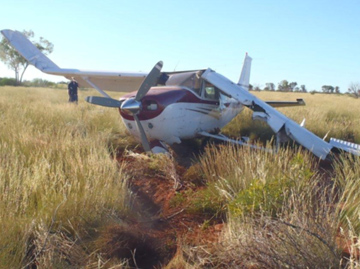
On 17 February 2014, a Cessna C206 aircraft, registered VH-YOT, departed runway 05 at Newman Airport, Western Australia, at about 0526 Western Standard Time (WST) for a charter flight to Cotton Creek in visual meteorological conditions. The pilot was the only occupant.
About 3 minutes after take-off, while in the climb and at about 1,500 feet above ground level, the pilot conducted a scan of the aircraft instruments and noticed that the engine oil pressure gauge was indicating zero. All the other engine instrument indications were in the normal range and the pilot tapped the oil pressure gauge but the indicator did not move. The pilot turned the aircraft back towards Newman airport. About 1 minute later, the pilot observed sparks coming from the engine cowling near the propeller, the engine power decreased and a severe vibration was felt through the airframe. The pilot pulled the mixture control to lean cut off to stop fuel flowing to the engine as he was concerned about an inflight fire and the propeller stopped rotating.
This accident highlights the importance of pre-flight decision making and planning for emergencies and abnormal situations.
The pilot determined that he would not be able to glide to runway 23 and began a scan to locate a suitable landing area that was away from power lines in the area. The pilot located a paddock that was about 4 km from the airport that appeared to be a suitable landing area and was near a dirt road. As the aircraft got closer to the landing area, the pilot could see what he initially thought was small shrubs, was actually medium sized trees. Prior to landing, the pilot shut down all non-essential aircraft systems.
On landing, the left wing impacted a tree and the aircraft spun around 180 degrees. The left wing was bent obstructing the only cockpit exit door. The fuel system had been disrupted and fuel was quickly entering the cockpit area. The pilot shut down all remaining systems and climbed into the rear section of the aircraft. The forward section of the cargo door was obstructed by the flaps in the full down position. The pilot exited the aircraft through the rear section of the cargo door and was not injured. The aircraft was substantially damaged.
Read the report: Engine failure involving a Cessna C206, VH-YOT, 4 km east-north-east of Newman Airport, Western Australia, on 17 February 2014
Additional reading: Managing partial power loss after take-off in single-engine aircraft


